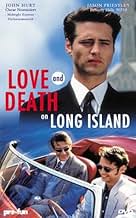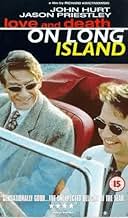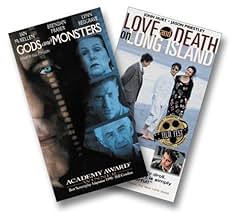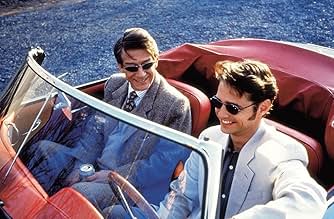Füge eine Handlung in deiner Sprache hinzuGiles De'Ath (Sir John Hurt) is a widower who doesn't like anything modern. He goes to movies and falls in love with movie star Ronnie Bostock (Jason Priestly). He then investigates everythi... Alles lesenGiles De'Ath (Sir John Hurt) is a widower who doesn't like anything modern. He goes to movies and falls in love with movie star Ronnie Bostock (Jason Priestly). He then investigates everything about the movie and Ronnie. After that, he travels to Long Island City, where Ronnie li... Alles lesenGiles De'Ath (Sir John Hurt) is a widower who doesn't like anything modern. He goes to movies and falls in love with movie star Ronnie Bostock (Jason Priestly). He then investigates everything about the movie and Ronnie. After that, he travels to Long Island City, where Ronnie lives, and meets him, pretending that Ronnie is a great actor, and that's why Giles admires ... Alles lesen
- Regie
- Drehbuch
- Hauptbesetzung
- 1 BAFTA Award gewonnen
- 4 Gewinne & 4 Nominierungen insgesamt
- Video Assistant
- (as Daniel Webb)
- Rob
- (as Dean Gariss)
Empfohlene Bewertungen
"I WRITE. I do not PROCESS words."
Giles De'Ath is a frail man on the verge of suffocating on high 19th century culture: he is sheltered within cafes, cigars, E.M. Forster, and presentations of lectures like "The Death of the Future." As one radio commentator asks him, "Does the 20th century play ANY part in your life?"
Giles is utterly changed by witnessing truly LOW culture on the big screen, the film Hotpants College II that he mistakes for E.M. Forster's Eternal Moment. Upon going for a second viewing, Giles is ashamed of even saying the name of the movie at first. He is mesmerized by the image of one Ronnie Bostock, Mikey in the film, a waiter who gets pushed around and finally shoved onto a restaurant counter and covered with ketchup, making Mikey a Christlike martyr for the Porky's generation. When the movie fades to black and the end credits come up, the name RONNIE BOSTOCK literally shines through the eyes of Giles De'Ath. So begins Giles' reluctant but determined search for this Bostock. He's seen all Ronnie's films and is transfixed by his image (indeed, Ronnie's movies are the first thing he's ever seen on a TV or a film screen.)
The second act of the movie takes Mr. De'Ath to Chesterton, Long Island- the home of Ronnie Bostock. De'Ath learns little by little about the modern American culture as he amusingly stalks his way into Ronnie's home. He offers his devotion to the career of Ronnie Bostock, who has decided he wants to be taken seriously as an actor.
Giles introduces him to an idea for a movie: a deaf-mute who has never been outside in the real world, who in fantasy is surrounded only by white, empty space, has in his possession a television to look outwards. After enough images, this childlike deaf-mute wants to experience the real world and must do it through fulfilling the quest of falling in love.
Bostock loves the idea, but he just doesn't GET it about Giles. That's DE'ATH's story. (It's strange when seeing the vision of Priestley in that script. I found myself wondering the effect of Teletubbies upon children, who may be both deaf and mute in certain ways and learn how to reach out towards reality through surreal television images. It's both troubling and poignant...)
Giles De'Ath is in love with the image of Ronnie Bostock: regardless of how low his movies are, Ronnie has a "file of smiles" for different emotions, "a permanence" in his look. His martyred state on the counter resembles old paintings. His film work is what Shakespeare would have done as both his comedies and Hotpants College 2 were made "for the rabble in the pit."
However, Giles, somewhere along the way, realizes that he is ALSO "completely, desperately" in love with Ronnie Bostock.
I won't give away the ending. The film is low-budget, short, and it has basically only two developed characters. It doesn't have much of an effect afterwards, but it has real poetry to it, especially in Hurt's transformation from high culture shelter to low culture inspiration. I'm still not sure if this is a high-culture indie making fun of low culture, or a low culture movie trying to justify itself, as Giles tries to do for Ronnie. One reason I hated Boogie Nights, among many, is that it wanted us to sympathize with Mark Wahlberg's porn star but also allowed us to distance ourselves from him and laugh AT him anytime we wanted: that's cheating. This film gets it right- it's not sarcastic about Ronnie's work, though certainly we have reasons to laugh at it. We have to draw our own conclusions about these characters, about the LOVE we see that Giles has for the star. Is this REAL love, or is it even more than that?
I'm a lover of film, and there are images that I see that I will pause, and play in slow motion, especially now with quicktime clips on the Mac: the poetry of a certain face, like that of Jodhi May(Alice) in Last of the Mohicans right before she jumps off the cliff. There's a love there for her, for her image, that is indescribable for me, so I can appreciate and truly relish the story of a man enamored by an image.
I'm also always glad to see a film about a man who finds inspiration in modernity. We know by the end that Giles is entering a new kind of life: perhaps "The De'Ath of the Future" is somebody who accepts all culture. He sees the low in the high and the high in the low, and he makes no distinction between the "art" of images in the art gallery and those of your everyday teen flick.
I've never seen Jason Priestley in anything else (hey, does that mean I'm like De'Ath, an old fuddy-duddy?), but he certainly holds his own in the face of an acting titan, just as Brendan Fraser did in Gods & Monsters - and yes, there are a LOT of similarities between the two films. And I really enjoyed Fiona Loewi's performance as his girlfriend - what else has she done? The smaller roles were extremely well cast (as others have noted, Maury Chaykin is a treat), even De'Ath's sister-in-law, who is only in one brief scene, but conveys a lot about how highbrow and inaccessible his novels are considered to be.
I'm also not the only one who has noticed echoes of Death in Venice, not only in the title and the storyline, but also, I'll swear at one point there was a Mahler symphony playing on the soundtrack - was that another nod? Then there is the artistic convention of the older mentor and the younger muse, which is explicitly raised in the film. There are a lot of interesting ideas about the nature of love, and about how even the most set in their ways can suddenly find a new lease of life.
This is a film that rewards more than one viewing. See it if only for a truly majestic performance from John Hurt, a masterclass in subtlety, defiance and thwarted passion.
I would give it a 9 or 10 if it did not provide some strange side trip details that don't add much except minutes to the consistency of the whole. Small complaint for a strong movie. Impress your friends/lovers with this one, almost no one has seen it in the States, I bet.
He becomes besotted with the image of a handsome young actor Ronnie Bostock (Jason Priestley) a favourite among teen-age movie-goers. It's as if he is starting a completely new life with a new warmth he has never known before.
The urge to help Ronnie in his career so that he will always be close to him is the predominant theme of the film. John Hurt's performance as the older man restraining his true feelings for a handsome young man of another generation is faultless and truly absorbing. Conversations between the two men are the highlights of the film and the confession scene extremely moving.
Ronnie Bostock's girl friend Audrey ( Fiona Loewi) is both charming and beautiful and adds a sweet touch to the story. She is responsible for bringing the writer and actor together. The story is punctuated with little episodes of wry humour brought about by people who live entirely different lives.
Altogether a very satisfying film that shows how some of us live in a cocoon unaware of the extreme joy and subsequent disappointment that lies beyond.
Wusstest du schon
- WissenswertesJohn Hurt said multiple times that he felt that this film represented his best work on film.
- PatzerWhen the mailman delivers mail to Ronnie Bostock's mailbox,he raises the mailbox flag, presumably to signal to the resident that mail has been delivered. (Ronnie's girlfriend, seeing the mailbox flag has been raised, seems to interpret the signal accordingly.) Although it may be the convention for mail delivery wherever the director/writer is from, it is not the case on Long Island, where it is the custom for the resident to raise the mailbox flag to alert the mailman that mail is in the mailbox waiting to be picked up. Once the mail has been picked up, the mailman lowers the flag - the opposite of what occurred in the film.
- Zitate
Taxi Driver: The sign says "no smoking."
Giles De'Ath: No, the sign says "thank you for not smoking." As I am smoking, I don't expect to be thanked.
Top-Auswahl
- How long is Love and Death on Long Island?Powered by Alexa
Details
- Erscheinungsdatum
- Herkunftsländer
- Sprache
- Auch bekannt als
- Eine Liebe auf Long Island
- Drehorte
- Produktionsfirmen
- Weitere beteiligte Unternehmen bei IMDbPro anzeigen
Box Office
- Bruttoertrag in den USA und Kanada
- 2.581.012 $
- Eröffnungswochenende in den USA und in Kanada
- 78.151 $
- 8. März 1998
- Weltweiter Bruttoertrag
- 2.581.012 $
- Laufzeit
- 1 Std. 33 Min.(93 min)
- Farbe
- Sound-Mix
- Seitenverhältnis
- 1.85 : 1






























